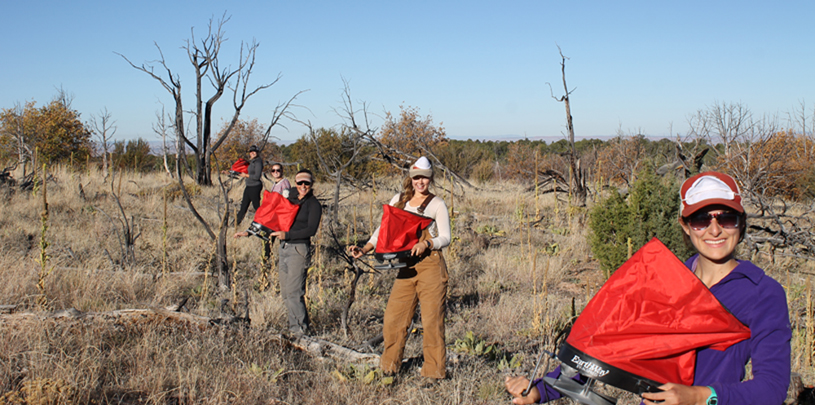

by Claire Martini, Citizen Science Volunteer Coordinator, AmeriCorps
A few deer hunters we pass along the rutted backroads of the Kaibab Plateau seem surprised by a lifted pick-up full of young women and our truck bed full of seed bags. “What are y’all doin’ out here?” they ask. I suppose we’re not the usual suspects. We’re out in the Kaibab National Forest on Kane Ranch as citizen scientists. Instead of rifles or hunting bows, we’re armed with bright red hand-crank seeders. Big bags of native seeds are our only ammunition.
This fall, fourteen Grand Canyon Semester students from Northern Arizona University volunteered on a service-learning trip to work on our “Greenstrips” project. Grand Canyon Trust is collaborating with ecologist Dr. Lauren Porensky to provide a field area to study the invasive species Bromus tectorum. Common name? Cheatgrass. Cheatgrass is one of the most pernicious invasive species on the Colorado Plateau and across the West.
Fun fact: cheatgrass got its name from the way farmers were “cheated” out of a full harvest when this species infiltrated their wheat fields.
Now, when cheatgrass moves into wildlands, we see increased fire frequency and intensity, increased erosion, and decreased species diversity. On the ground it’s easy to understand why cheatgrass is so good at taking over. A low, dense cheatgrass carpet blocks out natives. It’s insidious. And when it burns, the fires are hot, low, and destructive.
Lauren’s study examines how combining fuel breaks of native grasses and targeted grazing may weaken feedback between fire and cheatgrass invasion. Each time a landscape experiences wildfire, cheatgrass rebounds first. With the Grand Canyon Semester students, we planted five species in fuel breaks across many enclosure/exclosure pairs (meaning some of the fuel breaks will be grazed, others will not). In total, our hand-seeded greenstrips cover 67.2 acres!
“ELEL. POFE.” Botanical abbreviations, at first strange, began rolling off our tongues. Each of us adopted a grass species for the project, working in teams to plant meter-wide strips in randomized order. Out in the field, we spoke in shorthand. No real names necessary. “ACHY, you’re number three. SPCR, four. You’re five, PASM.”
On the last morning, we come together to wrap up the project. One student questions the role of humans in invasive species mitigation (he went on to do a semester-long project researching human influence at the ecosystem level). We talk about stewardship. We talk about place. We talk about what it feels like to be young and falling in love with this place.
Each of us gathered around the table in the chilly house that morning shared stories of our indebtedness to places of the heart—to those spaces that shaped who we are or who we wish to become. For some, it began early, growing up near Big Bend National Park, or digging for sandcrabs at the seashore. Others expressed a newfound love discovered during their semester around the Canyon, the excitement of the Inner Gorge and the sanctity of the Vishnu Schist. We held in common the belief that these wild places forged our identity.
Arizona writer Gary Paul Nabhan has asked, “What if every decision-maker were to admit that places can influence our destinies as much as other people can? What if each of us took it upon ourselves to honor and care for places luminous in our childhood or teenage memories much the way some of us have attempted to honor and care for revered elders?” For some of us, stewardship is the practice of honor and care for the places that made us. It feels like walking many miles on a November afternoon, arms full of native seeds.
Ready to get your hands dirty? Volunteer with us >
As 2024 draws to a close, we look back at five maps we created this year that give us hope for 2025.
Read MoreThe federal government will determine if the charismatic blue bird should be listed as threatened or endangered.
Read MoreWe can’t wait to meet you in a canyon, along a creek, or in the high alpine meadows of the Colorado Plateau.
Read More